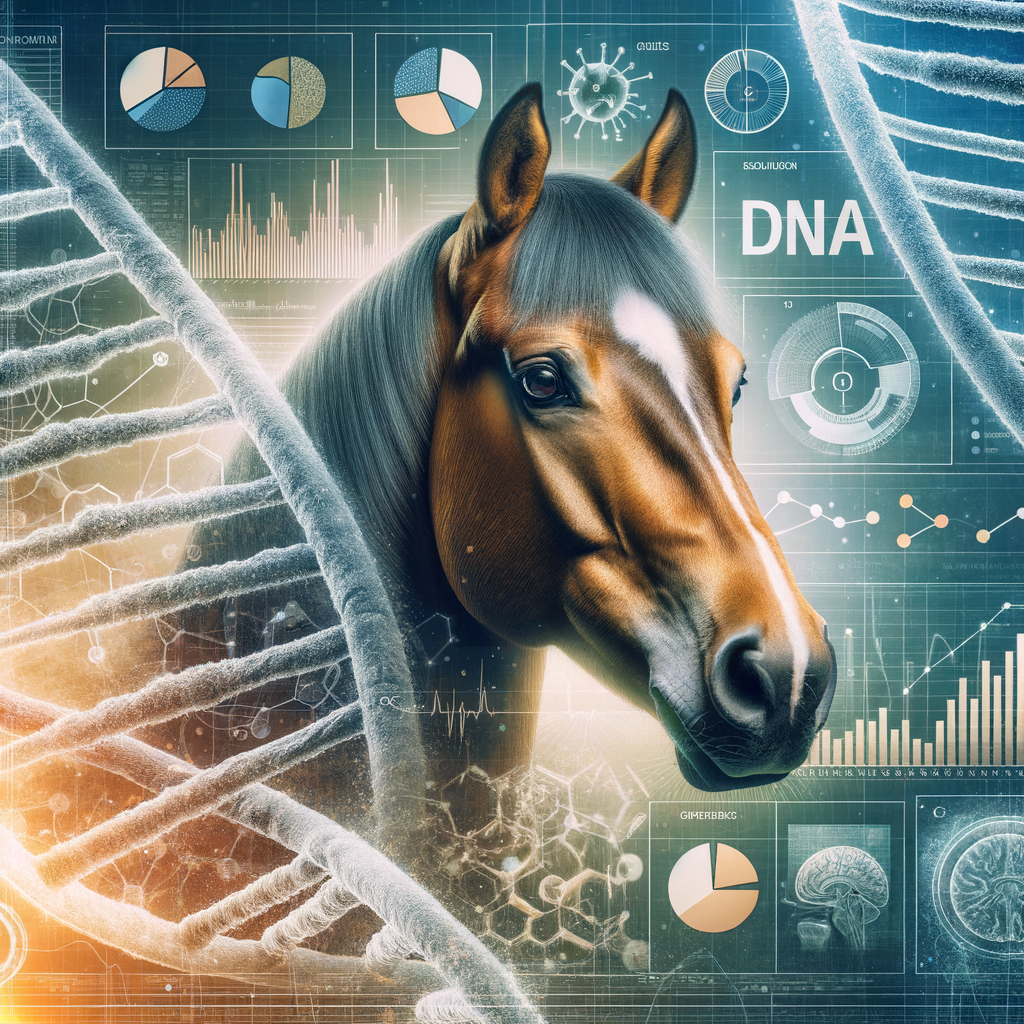
Introduction to Quarter Horse Genetics
Have you ever wondered why Quarter Horses are so unique? Why they have certain traits that make them stand out from other breeds? The answer lies in their genetics. In this article, we will delve into the fascinating world of Quarter Horse genetics and understand why they are the way they are.
- Understanding the Importance of Genetics in Horses
- Overview of Quarter Horse Breed Traits
Genetics play a crucial role in determining the physical characteristics, health, and behavior of horses. Just like in humans, horses inherit their genetic makeup from their parents. This genetic blueprint is what makes each horse unique. By studying horse genetics, we can better understand their traits, predict their potential, and even prevent certain genetic diseases.
The Quarter Horse is a popular breed known for its speed, agility, and muscular physique. These horses are often used in rodeos, horse shows, and for work on ranches. But what makes them so special? Let’s take a look at some of their key traits:
| Trait | Description |
|---|---|
| Speed | Quarter Horses are known for their incredible speed over short distances. They can outpace other breeds in races of a quarter mile or less, hence the name ‘Quarter Horse’. |
| Agility | These horses are not just fast, but also agile. They can change direction quickly, making them excellent for tasks that require quick movements, like herding cattle. |
| Muscular Physique | Quarter Horses have a compact, muscular body that gives them strength and power. This is particularly evident in their broad chest and powerful hindquarters. |
These traits are not just a result of training or environment, but are deeply rooted in the Quarter Horse’s genetics. As we delve deeper into this topic, we will explore how genetics influence these and other characteristics of the Quarter Horse breed.
Exploring Equine Genetics
In this section, we will delve into the fascinating world of equine genetics. We will start by understanding the basics of DNA and its role in equine traits. We will also explore how genetic research has advanced our understanding of horses.
Understanding Equine DNA
Equine DNA, like human DNA, is the blueprint for life. It contains all the information needed to create and maintain a horse. But what exactly is DNA, and how does it influence equine traits?
- Basics of DNA and its role in equine traits
- How genetic research has advanced our understanding of horses
DNA, or deoxyribonucleic acid, is a molecule that contains the genetic instructions for the development and function of living organisms, including horses. It’s like a recipe book that tells the body how to build and maintain itself.
In horses, DNA determines everything from the color of their coat to their athletic ability. For example, a specific gene called the “Extension” gene controls whether a horse will have a black or chestnut coat. Other genes can influence traits like speed, endurance, and jumping ability.
Over the years, genetic research has greatly advanced our understanding of horses. Scientists have sequenced the entire horse genome, identifying over 20,000 genes. This has allowed us to understand the genetic basis of many equine traits and diseases.
For instance, researchers have identified the genes responsible for certain hereditary diseases in horses, like Polysaccharide Storage Myopathy (PSSM). This knowledge allows breeders to test for these conditions and make informed breeding decisions to prevent the spread of these diseases.
In the next section, we will look at some common genetic traits unique to the Quarter Horse breed and how these traits influence the horse’s performance and health.
Genetic Traits of Quarter Horses
Let’s delve into the fascinating world of Quarter Horse genetics. These majestic creatures possess unique genetic traits that set them apart from other horse breeds. Understanding these traits can provide valuable insights into their performance and health.
- Common genetic traits unique to the Quarter Horse breed
- Speed Gene: This gene is responsible for their exceptional speed and agility. It’s predominantly found in Quarter Horses and is what makes them the fastest breed over short distances.
- Compact Body Gene: This gene gives Quarter Horses their distinctive compact and muscular body, making them well-suited for tasks requiring strength and agility.
- Coat Color Genes: Quarter Horses have a wide range of coat colors, from solid to patterned, which is a result of the interplay of various coat color genes.
- How these traits influence the horse’s performance and health
- Speed Gene: This gene gives Quarter Horses an edge in races and rodeo events. However, it can also make them more prone to certain injuries due to the high-intensity activities they are often involved in.
- Compact Body Gene: While this gene contributes to their strength and agility, it can also lead to certain health issues. For instance, their compact body structure can put more strain on their joints, leading to conditions like arthritis.
- Coat Color Genes: Certain coat colors in Quarter Horses have been linked to specific health conditions. For example, horses with the ‘Lethal White Overo’ gene can suffer from a fatal condition called Overo Lethal White Syndrome.
The Quarter Horse breed is known for its muscular build, compact body, and exceptional speed over short distances. These physical characteristics are largely due to their unique genetic makeup. Some of the common genetic traits found in Quarter Horses include:
The genetic traits of Quarter Horses not only define their physical appearance but also significantly influence their performance and health. Let’s explore how:
Understanding the genetic traits of Quarter Horses is crucial for breeders, owners, and horse enthusiasts alike. It not only helps in predicting their performance but also in providing them with the best possible care and management.
Quarter Horse Characteristics and Their Genetic Basis
Let’s delve into the fascinating world of Quarter Horse genetics and explore the characteristics that make this breed unique. We’ll focus on the physical traits of Quarter Horses and how their genetic makeup influences these traits.
Physical Traits
Physical traits are the characteristics that we can see. They include the horse’s size, color, and shape. In Quarter Horses, these traits are not just about looks – they also play a crucial role in the horse’s performance.
- Exploring the genetic basis for common physical traits in Quarter Horses
- Examples of physical traits and their influence on the horse’s performance
Genes are like a blueprint for a horse’s physical traits. They determine everything from the horse’s height to the shape of its hooves. For example, the Quarter Horse’s compact size and muscular build, which are ideal for quick sprints, are a result of specific genes.
Let’s take a closer look at some specific physical traits and how they impact a Quarter Horse’s performance:
| Physical Trait | Genetic Basis | Impact on Performance |
|---|---|---|
| Compact Size | Genes that regulate growth and development | Allows for quick acceleration and agility |
| Muscular Build | Genes related to muscle development and strength | Provides power for short, fast sprints |
| Hard Hooves | Genes involved in keratin production | Offers durability and traction on various surfaces |
As we can see, the physical traits of a Quarter Horse are not just about aesthetics. They have a direct impact on the horse’s ability to perform in various activities, from racing to rodeo events. Understanding these traits and their genetic basis can help breeders and trainers optimize a horse’s performance and wellbeing.
Behavioral Traits
Behavioral traits in Quarter Horses are as important as their physical traits. These behaviors, just like physical traits, have a genetic basis. Understanding these traits can significantly impact how we train and improve the performance of these horses.
-
Understanding the genetic basis for behavioral traits in Quarter Horses
Every Quarter Horse is unique, and their behavior is influenced by their genetics. Scientists have discovered that certain genes are responsible for specific behaviors in horses. For instance, the ‘fear gene’ is associated with how a horse reacts to new or threatening situations. A horse with a dominant ‘fear gene’ might be more cautious and alert, while one with a recessive ‘fear gene’ might be more relaxed and easy-going.
Another example is the ‘learning gene’. This gene influences how quickly a horse can learn new tasks. A horse with a dominant ‘learning gene’ might pick up new skills faster than one with a recessive ‘learning gene’. Understanding these genetic influences can help us better tailor our training methods to each individual horse.
-
How these traits can influence training and performance
The understanding of these genetic behavioral traits is crucial in training Quarter Horses. For example, a horse with a dominant ‘fear gene’ might require more time and patience during training, especially when introduced to new environments or tasks. On the other hand, a horse with a dominant ‘learning gene’ might excel in complex tasks and competitions that require quick thinking.
Therefore, understanding the genetic basis of these behavioral traits can help trainers develop personalized training programs. This can lead to improved performance, as the horse’s training is aligned with its natural tendencies and abilities.
In conclusion, understanding the genetic basis for behavioral traits in Quarter Horses can significantly influence their training and performance. By tailoring training methods to each horse’s unique genetic makeup, we can help them reach their full potential and excel in their performance.
Case Studies in Quarter Horse Genetic Studies
Let’s delve into some of the most significant studies that have been conducted on Quarter Horse genetics. These studies have not only increased our understanding of the breed’s unique traits but also have practical applications in breeding and horse health.
- Review of Key Studies Exploring Quarter Horse Genetics
- The Genetic Link to Speed: A study conducted in 2012 discovered a specific gene, called the ‘Speed Gene’, which is predominantly found in Quarter Horses. This gene is linked to the horse’s ability to sprint short distances quickly.
- Genetic Basis of Coat Color: Another study in 2015 found that the wide variety of coat colors in Quarter Horses can be traced back to a handful of genes. This study has helped breeders predict the coat color of foals.
- Genetic Predisposition to Diseases: A 2018 study identified certain genetic markers in Quarter Horses that make them more susceptible to specific diseases, such as Polysaccharide Storage Myopathy (PSSM).
- Insights Gained from These Studies and Their Practical Applications
- Speed Gene: The identification of the ‘Speed Gene’ has allowed breeders to selectively breed horses for speed, improving the performance of Quarter Horses in racing and rodeo events.
- Coat Color Genes: Understanding the genetic basis of coat color has enabled breeders to predict the coat color of foals, allowing them to breed horses with desired colors.
- Disease Predisposition: The discovery of genetic markers for diseases has led to the development of genetic tests. These tests can identify horses that are at risk of developing certain diseases, enabling early intervention and treatment.
Several studies have been conducted to understand the genetic makeup of the Quarter Horse. Here are a few noteworthy ones:
These studies have provided valuable insights into the Quarter Horse breed and have practical applications:
These case studies demonstrate the power of genetic research in understanding and improving the Quarter Horse breed. As we continue to explore equine genetics, we can expect even more exciting discoveries in the future.
Future of Horse Genetic Research
As we look towards the future, it’s clear that the field of horse genetic research is poised for exciting developments. Let’s explore some of the potential trends and how they might influence the breeding and training of Quarter Horses.
- Predicting Future Trends in Equine Genetic Research
One of the most significant trends we can expect to see is a greater emphasis on genetic diversity. This is crucial for maintaining the health and vitality of horse populations. Scientists are likely to use advanced technologies to map the genetic diversity of various horse breeds, including Quarter Horses.
Another trend is the increased use of genetic testing in breeding programs. This can help breeders select horses with desirable traits and avoid those with genetic disorders. The use of genetic data could also help improve the performance of racehorses, by identifying genes associated with speed and endurance.
Finally, we can expect to see more research into the genetic basis of horse behavior. This could lead to better training methods, as trainers could tailor their techniques to the individual horse’s genetic makeup.
- How These Trends Could Influence the Breeding and Training of Quarter Horses
These trends in horse genetic research could have a significant impact on the breeding and training of Quarter Horses. For instance, by understanding the genetic diversity of the breed, breeders could make more informed decisions about which horses to mate. This could help maintain the breed’s health and vitality for generations to come.
The increased use of genetic testing could also help breeders select Quarter Horses with desirable traits, such as speed, agility, and a calm temperament. This could lead to a breed that is even better suited to its traditional roles in racing and ranch work.
Finally, understanding the genetic basis of horse behavior could revolutionize the way Quarter Horses are trained. Trainers could use this knowledge to develop methods that are tailored to each horse’s genetic makeup, leading to more effective and humane training practices.
In conclusion, the future of horse genetic research holds exciting possibilities for the breeding and training of Quarter Horses. By embracing these trends, we can ensure that this beloved breed continues to thrive.
Conclusion: The Impact of Genetics on the Quarter Horse Breed
As we draw to a close on our exploration of Quarter Horse genetics, it’s clear that the science of genetics plays a pivotal role in shaping the traits and characteristics of this unique breed. Let’s summarize our findings and reflect on the potential future impact of genetic research on the Quarter Horse breed.
- Summarizing the role of genetics in shaping Quarter Horse traits:
- Reflecting on the potential future impact of genetic research on the breed:
Genetics is like a blueprint that determines the physical and behavioral traits of Quarter Horses. From their muscular build, speed, and agility to their calm demeanor and learning abilities, everything is influenced by their genes. For instance, the ‘Speed Gene’ is responsible for their exceptional sprinting capabilities, while the ‘Calm Gene’ contributes to their easy-going nature. Through various case studies, we’ve seen how genetic research has helped us understand these traits better.
Looking ahead, genetic research holds immense potential for the Quarter Horse breed. With advancements in technology, we can expect more detailed genetic mapping, leading to a deeper understanding of the breed’s traits. This could pave the way for healthier horses, as potential genetic diseases could be identified and addressed earlier. Moreover, it could also lead to the development of more specialized Quarter Horses, tailored for specific tasks or sports.
In conclusion, genetics has a profound impact on the Quarter Horse breed, shaping its present and influencing its future. As we continue to unravel the mysteries of equine genetics, we can look forward to a future where we understand these magnificent creatures even better.









